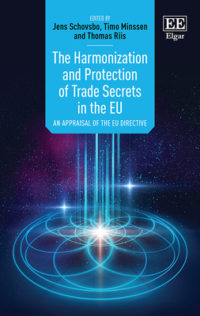The Trade Secrets Directive, Implementation, Application and Implications

A review of “The Harmonization and Protection of Trade Secrets in the EU – An Appraisal of the EU Directive” Edited by Jens Schovsbo, Timo Minssen and Thomas Riis. Edward Elgar, Cheltenham, UK and Northampton, USA, 2020, 321 pages.
Directive (EU) 2016/943 of the European Parliament and of the Council on the protection of undisclosed know-how and business information (trade secrets) against their unlawful acquisition, use and disclosure, (2016) OJ L 157/1), (TSD) was adopted on 8 June 2016 and expected to be implemented by the EU Member States by the latest on 9 June 2018. In Finland, for instance, it was implemented, slightly late, by a new law, i.e. The Act on Trade Secrets, FITSA, Liikesalaisuuslaki 595/2018. The act came into force on 15 August 2018 (20 §).
The book on the TSD edited by the three Danish professors comprises four parts. As explained in the brief introduction “An appraisal of the EU Directive on Trade Secrets”, Part I gives a general framework of the TSD, describes it and its background in some more detail and puts it into a broader context of Information law. It is also viewed through American eyes. The following part, Part II, discusses the implementation of the TSD in the Nordic countries, the UK, Germany and Spain as well as Portugal. Part III deals with specific issues, such as those which touch upon other sectors of law like employment law, more specifically labor mobility, choice of law, big data and artificial intelligence, and enforcement. The articles in the last section, Part IV, ponder on issues connected with a new iteration of DNA sequencing called Adaptive immune receptor repertoire sequencing (AIRR), protection of artificial intelligence (AI) in personalized medicine, and the impact of trade secrets (TS) for publicly funded research collaboration.
The book is well structured offering a path from the general to the very specific.
Of the 15 articles written by all together 17 academics with the addition of one judge, it is obvious that not all articles are of immediate interest for IPR practitioners, if they do not happen to be involved in assisting with legal implications on medical or biomedical matters or involved in research issues. These articles do, however, offer a well written and readable view on how trade secrets affect the areas in question.
Parts I and II, and the articles in Part III concerning labor mobility, choice of law and enforcement are, however, most useful reads also for a practically oriented IPR-person, be she or he a lawyer, engineer or an individual with any other professional background involved in advising clients on legal, i.e. particularly TS-matters. For a lawyer particularly, who has been educated according to the notion that “the devil is in the details” – as it unfortunately many times is -, this book gives a necessary and good overall picture of the TSD and how it has been implemented in a common law type jurisdiction and within civil law jurisdictions, such as the Nordic countries, Germany as well as Spain and Portugal.
In the article on the implementation of the TSD in the Nordic countries Norway has, unfortunately, been left out. This appears to be due to the fact that by the end of December 2018 – apparently the deadline for submitting the articles – no Norwegian Act in this respect had been adopted. This shows a weakness with this type of publication taking into account that the book was published early fall this year. The rigorous proof reading and language checking take far too long, although they do of course enhance the quality.
For those who like to acquaint themselves with the TS-legislation in more detail in Norway, and also in Denmark, Finland and Sweden, are recommended to take a closer look at NIR 4 2018.
The article on the TSD and employees is particularly interesting taking into account that Sweden apparently has taken a more liberal stand on labor mobility than the Directive. The author notes, among other things, that the balance achieved between employees and employers has been found to be satisfactory during the years. The Swedish Act on Trade Secrets was enacted already in 1990 and the legislator has tried to preserve it as much as possible despite the TSD.
It can be mentioned that there are some studies showing that employee mobility, although sometimes detrimental for a single employer, can enhance the economy as a whole. It remains to be seen if there will be cases finding their way to the EUCJ.
For those involved in TS, but also for those interested in getting a view on how EU Directives are implemented, and how differently it can be done from adapting the text from the Directive more or less in extenso to trying to adapt the Directive to existing legislation, the book is warmly recommended.
It will be interesting to follow how various events, such as Brexit, will impact on the application of TS, and what kind of role TS will establish for themselves in the European company portfolio. If nothing else the TSD has done an important job in consolidating the legislation in the various Member States despite a number of differences still remaining, and the Danish professors, together with the other writers, in describing and commenting upon this legal instrument.
Kirjoittajat


